Going Green with Harimaen: The Origin of Morihata Organic Matcha
Most trips to Central Japan include a few major stops: Osaka, Nara, Kobe, and – unquestionably – Kyoto. And with each place having its own landmarks and local specialties, from Nara’s deer to Osaka’s Dōtonbori, there’s good reason to keep them on the itinerary. But very few travelers know that, only an hour’s ride from Kyoto Station awaits the undisputed matcha capital of the world: Uji, Japan.
It’s here, in the emerald hills of Uji, that Morihata matcha finds its origins. Just east of the city proper lies Harimaen Seicha (est. 1880), one of the area’s most renowned producers of matcha, bancha, sencha, and gyokuro tea. Their centuries of success can largely be attributed to two main factors: unwavering commitment to quality tea and the signature tea-shading process known as Ōishita Saibai.
To become true matcha, all tea must undergo some amount of shading in the field. As a general rule, longer shade duration leads to higher concentrations of things like tannins, antioxidants, and chlorophyll – the pigment responsible for matcha’s deep green hue. Following the Ōishita Saibai method, Harimaen shades the leaves (called tencha) in the weeks directly preceding harvest. Doing so imparts the tencha (and subsequently, the matcha) with an ideal balance of essential nutrients and key umami components.
After harvest, the leaves head to the factory to be steamed, dried, and de-stemmed according to specification. This part of the process happens relatively quickly, with matcha leaves only requiring about twenty seconds to steam and 20 to 30 minutes to dry. Finally, they are finely ground with a stone mill and packaged into matcha powder as it’s seen on store shelves. In the case of Morihata matcha, the quality – or grade – of the final product is divided into tiers: Sei, Waka, and Jun. While all three are suited for ceremonial use, certain grades (like Sei) lend themselves nicely to culinary application while others (Waka and Jun) are best enjoyed as a standalone beverage.
It is through dedication and a sincere love for green tea that Harimaen Seicha has, even in the matcha capital, held its own for so long. As of 1975, they’ve furthered their efforts to make great tea with minimal impact by going pesticide-free throughout their entire operation. Organic farming might demand more frequent weeding and care given to the fields, but Harimaen takes pride in knowing that their land is happier, their workers healthier, and their matcha more delicious than ever before.


